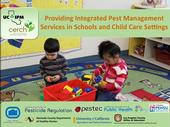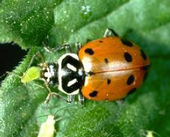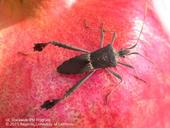- Author: Cheryl Reynolds
- Author: Andrew Mason Sutherland
- Author: Tunyalee A. Martin

California requires that pest control companies providing services in schools and licensed child care centers comply with a series of laws called the Healthy Schools Act (HSA). The HSA promotes IPM and seeks to minimize pesticide exposure to children in all public K–12 schools and licensed private child care centers.
Providing Integrated Pest Management Services in Schools and Child Care Settings is the new free online training module available from UC IPM that explains the history of the Healthy Schools Act and details what schools, child care centers, and pest control companies are required to do to follow the...
- Author: Karey Windbiel-Rojas

The UC Statewide IPM Program is hiring an Urban IPM Educator to assist with extending pest management information to a variety of urban audiences. This exciting position is perfect for anyone interested in pests, horticulture, teaching, and educating. The deadline to apply is January 22, so get your application in soon!
-----
Community Education Specialist III (Urban IPM Educator)
Location: UC ANR- Davis (Yolo County)
Under the direction of the Associate Director for Urban & Community IPM, the Urban IPM Educator will support the urban IPM outreach and education program by coordinating activities, carrying out train-the-trainer educational...
![Brownish adult, yellow nymphs, and white wax of Asian citrus psyllids, Diaphorina citri Kuwayama. [Photo by Michael E. Rogers, University of Florida]](https://ucanr.edu/blogs/UCIPMurbanpests/blogfiles/25390small.jpg)
Every year, California receives, on average, six new exotic invasive pests of concern; that's about one new pest every 60 days. These may be plants, insects or other arthropods, mollusks, plant pathogens such as fungi and bacteria, vertebrates, or any other organism not native to our state and with the capacity to negatively impact agriculture, urban environments and/or natural ecosystems. These invasive pests enter California on plant material and other biological substrates, as hitchhikers on trade goods and in ship ballast water, and sometimes even because of smuggling operations. Without the natural enemies that kept them in check in their native lands, they are free to reproduce and wreak havoc. Such pest invasions may then lead to...
- Author: Chuck Ingels
- Author: David Robert Haviland
![Fig.3. Leaffooted bug nymphs on Hesperaloe parviflora.[Photo by K. Windbiel-Rojas]](https://ucanr.edu/blogs/UCIPMurbanpests/blogfiles/23551small.jpg)
[From the July 2014 issue of the UC IPM Retail Nursery & Garden Center News]
In recent years, you may have seen a strange “new” bug in your garden, especially on tomatoes and pomegranates. These insects may be leaffooted bugs. Although they are native to the western United States and not new to California, leaffooted bugs seem to be occurring more commonly in gardens. These distinctive bugs get their name from the small leaf-like enlargements on the hind leg (Figure 1). They are medium to large sized insects that prefer to feed on fruits and seeds and are often found in...

An army of leaffooted bugs attacking pomegranates, tomatoes or other plants in your garden can be quite disconcerting. They are large, long-legged bugs with a big appetite for fruits and seeds. After overwintering as adults in protected areas such as wood piles or outbuildings, they emerge to feed on seeds of winter weeds and then head out to farms and gardens in search of early season fruit and a place to lay eggs.
To learn more about identification, biology and management of these bugs, read the newly published Pest Note: Leaffooted Bugs authored by Chuck Ingels, UCCE Sacramento County and David Haviland, UCCE Kern County.


